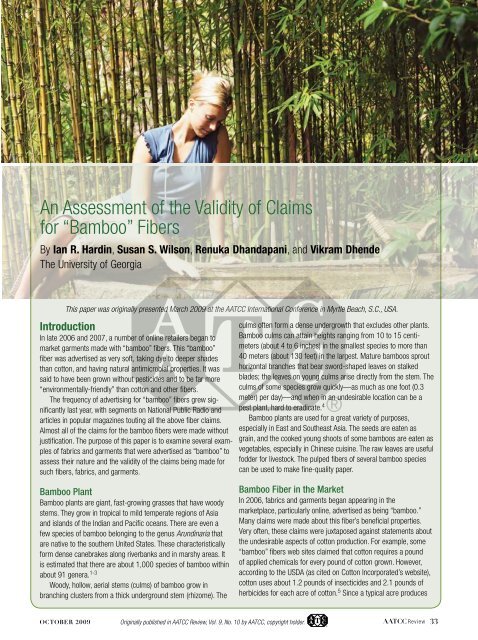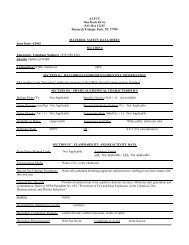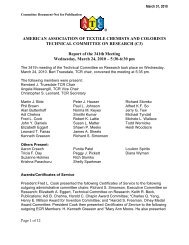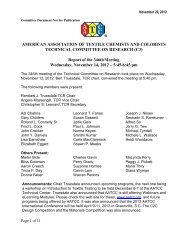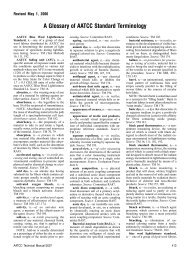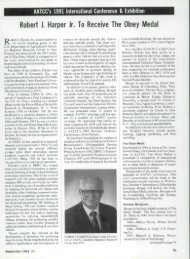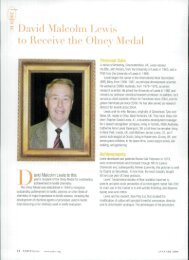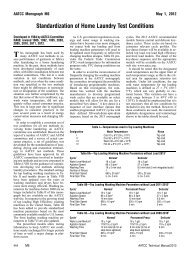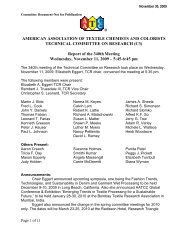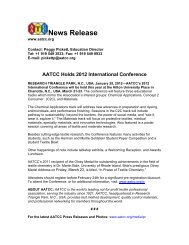A A C C T
A A C C T
A A C C T
You also want an ePaper? Increase the reach of your titles
YUMPU automatically turns print PDFs into web optimized ePapers that Google loves.
An Assessment of the Validity of Claims<br />
for “Bamboo” Fibers<br />
By Ian R. Hardin, Susan S. Wilson, Renuka Dhandapani, and Vikram Dhende<br />
The University of Georgia<br />
OCTOber 2009<br />
A<br />
A<br />
C<br />
C<br />
T ®<br />
This paper was originally presented March 2009 at the AATCC International Conference in Myrtle Beach, S.C., USA.<br />
Introduction<br />
In late 2006 and 2007, a number of online retailers began to<br />
market garments made with “bamboo” fibers. This “bamboo”<br />
fiber was advertised as very soft, taking dye to deeper shades<br />
than cotton, and having natural antimicrobial properties. It was<br />
said to have been grown without pesticides and to be far more<br />
“environmentally-friendly” than cotton and other fibers.<br />
The frequency of advertising for “bamboo” fibers grew significantly<br />
last year, with segments on National Public Radio and<br />
articles in popular magazines touting all the above fiber claims.<br />
Almost all of the claims for the bamboo fibers were made without<br />
justification. The purpose of this paper is to examine several examples<br />
of fabrics and garments that were advertised as “bamboo” to<br />
assess their nature and the validity of the claims being made for<br />
such fibers, fabrics, and garments.<br />
Bamboo Plant<br />
Bamboo plants are giant, fast-growing grasses that have woody<br />
stems. They grow in tropical to mild temperate regions of Asia<br />
and islands of the Indian and Pacific oceans. There are even a<br />
few species of bamboo belonging to the genus Arundinaria that<br />
are native to the southern United States. These characteristically<br />
form dense canebrakes along riverbanks and in marshy areas. It<br />
is estimated that there are about 1,000 species of bamboo within<br />
about 91 genera. 1-3<br />
Woody, hollow, aerial stems (culms) of bamboo grow in<br />
branching clusters from a thick underground stem (rhizome). The<br />
Originally published in AATCC Review, Vol. 9, No. 10 by AATCC, copyright holder. A A<br />
culms often form a dense undergrowth that excludes other plants.<br />
Bamboo culms can attain heights ranging from 10 to 15 centimeters<br />
(about 4 to 6 inches) in the smallest species to more than<br />
40 meters (about 130 feet) in the largest. Mature bamboos sprout<br />
horizontal branches that bear sword-shaped leaves on stalked<br />
blades; the leaves on young culms arise directly from the stem. The<br />
culms of some species grow quickly—as much as one foot (0.3<br />
meter) per day)—and when in an undesirable location can be a<br />
pest plant, hard to eradicate. 4<br />
Bamboo plants are used for a great variety of purposes,<br />
especially in East and Southeast Asia. The seeds are eaten as<br />
grain, and the cooked young shoots of some bamboos are eaten as<br />
vegetables, especially in Chinese cuisine. The raw leaves are useful<br />
fodder for livestock. The pulped fibers of several bamboo species<br />
can be used to make fine-quality paper.<br />
Bamboo Fiber in the Market<br />
In 2006, fabrics and garments began appearing in the<br />
marketplace, particularly online, advertised as being “bamboo.”<br />
Many claims were made about this fiber’s beneficial properties.<br />
Very often, these claims were juxtaposed against statements about<br />
the undesirable aspects of cotton production. For example, some<br />
“bamboo” fibers web sites claimed that cotton requires a pound<br />
of applied chemicals for every pound of cotton grown. However,<br />
according to the USDA (as cited on Cotton Incorporated’s website),<br />
cotton uses about 1.2 pounds of insecticides and 2.1 pounds of<br />
herbicides for each acre of cotton. 5 Since a typical acre produces<br />
C<br />
C<br />
T ®<br />
AATCC Review 33<br />
App lied Tech
App lied Tech<br />
about 800 pounds of cotton, 0.004 pound (0.066 ounce) of<br />
pesticides would be used per pound of cotton grown, based on<br />
this calculation.<br />
An examination of most of the advertisements for “bamboo”<br />
fibers, fabrics, or garments shows that many, if not most, are using<br />
information from one company in China that has made the above<br />
claims and others, sometimes in a way that confuses the attributes<br />
of rayon and bast fibers. The language on most internet sites for<br />
bamboo fibers and garments seems to indicate that the fiber being<br />
marketed is rayon rather than a bast fiber from the stem of the<br />
bamboo plant.<br />
One source of bamboo fiber, clearly from the plant stem, was<br />
found after an extensive literature and web search. This was Litrax<br />
GmbH, a company based in Switzerland. 6 Its web site describes its<br />
bamboo fiber as “extracted biologically from the bamboo stem.”<br />
The process is described as “enzyme retting, steaming, boiling,<br />
bleaching.” The fiber cross-section (Fig. 1) from the Litrax web<br />
site, 6 is kidney shaped to oval, with a hollow core characteristic of<br />
natural cellulosic fiber. The fibers are described as having a fineness<br />
of 7 to 67 microns, with a median of ~ 29 microns.<br />
Of note in Fig. 1 is the irregular shape of the cross-sections,<br />
with lumens clearly visible in many of the fibers. In Fig. 2, nodes<br />
characteristic of many bast fibers are also clearly evident. The<br />
staple length of the Litrax fibers varies from 15 to 159 mm (0.6 to<br />
6.3 in.) with a median staple length of 2.6 in. The fiber tenacity is<br />
14.2 cN/tex. (1.67 g/den.). Litrax also claims that the bamboo fiber<br />
(from the stem of the plant) eliminates Staphylococcus aureus in an<br />
antibacterial test. 6<br />
A<br />
A<br />
Bamboo Fiber in the Scientific Literature<br />
Several investigators have examined bamboo as a source of bast<br />
fiber, and as a source of cellulose from pulping the bamboo. Ray,<br />
et al., 7 studied the microstructure of an Indian bamboo. Just inside<br />
the epidermis was the layer of hypodermis, mostly made up of<br />
the sclerenchyma cells that are the bamboo fibers. The structure<br />
and the location of the fibers were quite similar to what is seen in<br />
the flax plant. Rao and Rao8 examined natural fibers from vakka<br />
(a palm tree), date palm leaf stalks, and bamboo fibers from the<br />
main stalk of that grassy plant. Bamboo fibers were obtained by<br />
first removing the node and the thin bark of the main stalk. The<br />
culm was then soaked for three days and beaten and scraped<br />
to remove the individual fibers. An entirely chemical method of<br />
degumming was also used to obtain fibers. The cross-sections of<br />
the bamboo fibers were approximately circular.<br />
He, et al., 9 prepared and analyzed cellulose pulp from bamboo<br />
Cizhu (Dendrocalamus affinnis). They obtained 51% cellulose from<br />
the bamboo after chemical processing. This was similar to the<br />
yield from hardwoods (42%-51%) and more than that from softwoods<br />
(39%-43%). The lignin content was similar to hardwoods<br />
(~22%), but lower than from softwood (~30%).<br />
In a study that relates directly to validation of some of the<br />
bamboo fiber claims, Xu, et al., 10 reported on the structure and<br />
thermal properties of bamboo viscose, lyocell, and conventional<br />
viscose (rayon) fibers. The SEM micrographs of the bamboo<br />
viscose confirmed that it was identical to conventional rayon in<br />
configuration. All three of the fibers showed a typical cellulose II<br />
pattern by wide angle X-ray diffraction (WAXR). The WAXR pattern<br />
for conventional rayon and the bamboo cellulose rayon were very<br />
similar, with a crystallinity of 53% and 45%, respectively. Lyocell<br />
crystallinity was higher at 69%. Thermal analysis of the three<br />
fibers showed behavior typical of cellulose II fibers, with small<br />
differences that would be expected from the differing<br />
crystallinity indexes.<br />
C<br />
C<br />
T ®<br />
Hypotheses<br />
Based on claims made in marketing the “bamboo” fibers, and the<br />
properties of other bast fibers, it was hypothesized that:<br />
1. The “bamboo” fibers, yarns, fabrics, and garments being<br />
offered, primarily on the internet, were actually rayon made from<br />
cellulose derived from bamboo plants after pulping, similar to<br />
pulping done to trees.<br />
2. The “bamboo” fibers, yarns, fabrics, and garments advertised<br />
as having antibacterial properties would not, in fact, exhibit these<br />
qualities when tested by standard procedures.<br />
Fig.1. Cross-sections of bamboo bast fiber. 4 Fig. 2. Longitudinal view of bamboo bast fiber. 4<br />
34 AATCC Review www.aatcc.org Originally published in AATCC Review, Vol. 9, No. 10 by AATCC, copyright holder. OCTOber 2009<br />
A C<br />
A T C<br />
®
a) b)<br />
Fig. 3. Micrograph of cross-section of a) spun viscose and b) “bamboo” woven fabric.<br />
a) b)<br />
Fig. 4. SEM photograph of a) spun viscose and b) “bamboo” woven fabric.<br />
OCTOber 2009<br />
A<br />
A<br />
Materials and Procedures<br />
Fabrics Tested<br />
Bamboo fabric samples (7) were purchased over the internet from<br />
a variety of sources. Each of the sources made claims for the<br />
bamboo fiber contained within its products. These included claims<br />
of antimicrobial properties, the ability to evaporate sweat quickly,<br />
never sticking to the skin in hot weather, ultraviolet radiation<br />
protection, and production in a green process without any pollution.<br />
Typically, “bamboo” advertisements insisted it was the most<br />
environmentally friendly fiber available. Specimens from these sites<br />
were picked to give a variety of fabrics and garment products. The<br />
samples examined are listed in Table I, along with other fabrics that<br />
were used for comparisons.<br />
Microscopy<br />
Fibers from each of the seven samples were extracted and crosssections<br />
prepared. These were examined by optical microscopy and<br />
by scanning electron microscopy (SEM). These cross-sections were<br />
compared to those in the literature from rayon and bast fibers.<br />
Antimicrobial Testing<br />
Specimens were tested for antimicrobial activity using AATCC<br />
Test Method 147. A Gram-positive bacterium, Staphylococcus<br />
aureus, and a Gram-negative one, Escherichia coli, were used in<br />
the testing. S. aureus is the most common cause of various staph<br />
infections, and is one of the four most common causes of nocosomial<br />
(hospital-acquired) infections. These are most often associated<br />
with post-surgical wound infections. E. coli is commonly found in<br />
C<br />
C<br />
T ®<br />
Originally published in AATCC Review, Vol. 9, No. 10 by AATCC, copyright holder. A A<br />
the lower intestine. Some strains can cause very serious<br />
food poisoning, though most are harmless.<br />
Results<br />
Fiber Identification<br />
Microscopy results are shown in Figs. 3 and 4. When<br />
these photographs were compared to standards for<br />
conventional rayon fibers, there was little difference to<br />
note. Comparisons to bast fibers, and to the microphotographs<br />
from Listrax, showed conclusively that the<br />
samples tested were not bast fibers. Fig. 5 shows a<br />
comparison of the viscose rayon sample and that of a<br />
typical “bamboo” fiber taken from the fabric samples.<br />
Antimicrobial Testing<br />
Typical results from antimicrobial testing are shown in<br />
Fig. 6. These tests showed that none of the “bamboo”<br />
samples tested had any antimicrobial properties.<br />
Bacterial colonies grew straight across the agar plate<br />
where streaking had been done. A remarkable contrast<br />
was the antimicrobially-treated nonwoven fabric that<br />
was several years old. This specimen showed the contrast<br />
between effectiveness and no effectiveness at all.<br />
Summary and Conclusions<br />
Fabric samples (7) advertised as bamboo fibers were obtained<br />
and tested by optical microscopy and SEM, and compared to<br />
known samples of rayon and bast fibers. These same samples<br />
were tested for antimicrobial properties against S. aureus and<br />
E. coli. The results showed that the fibers in question are almost<br />
certainly rayon, perhaps made from purified cellulose isolated<br />
from bamboo pulp.<br />
The hypotheses were confirmed. The fibers in questions are<br />
not bast fibers from bamboo, but are rayon from bamboo-derived<br />
cellulose. Further, these fabrics have no antimicrobial properties,<br />
in great contrast to claims being widely circulated by marketers.<br />
A further conclusion might be offered. Rayon production is an<br />
inherently chemical-intensive and potentially polluting process.<br />
With this rayon coming from China, where environmental controls<br />
a) b)<br />
Fig. 5. Longitudinal view of fibers taken from a) rayon fabric and b)<br />
“bamboo” woven fabric.<br />
C<br />
C<br />
T ®<br />
AATCC Review 35<br />
App lied Tech
App lied Tech<br />
a)<br />
c) d)<br />
Fig. 6. Assessment of antibacterial properties using AATCC Test Method 147 and S. aureus on a)<br />
nonwoven fabric treated with an antimicrobial finish (triclosan), b) “bamboo” woven, c) spun viscose<br />
fabric, and d) bamboo nonwoven towelette.<br />
are rare, these fibers and the fabrics and garments made with<br />
them may be the least environmentally-friendly choice a consumer<br />
could make.<br />
A<br />
A<br />
Governmental Actions<br />
The US Federal Trade Commission (FTC) held hearings about the<br />
“bamboo” issue in August 2008, with several representatives from<br />
academia and business testifying as to the validity of bamboo as<br />
a unique fiber. No immediate action was taken, but on August<br />
11, 2009, the FTC put out a press release entitled “FTC Charges<br />
Companies with ‘Bamboo-zling’ Consumers with False Product<br />
Claims.” 11 The FTC charged four sellers with “deceptive labeling<br />
and advertising … items as made from bamboo fiber, when they<br />
are made of rayon.” The<br />
Table I.<br />
“bamboo” Fabrics/Garments<br />
and Sources<br />
Fabric or Garment Source<br />
Bamboo Jersey Slip Bamboosa<br />
Bamboo Compressed<br />
Towelette<br />
Shirts of Bamboo<br />
Bamboo Satin Bamboofabric Store<br />
Bamboo Woven Bamboo Fabric<br />
Store (Australia)<br />
Bamboo Towel Ecofabric<br />
Bamboo Shawl Ecofabric<br />
Bamboo ecoKashmere Jonano<br />
Hemp Fabric -<br />
Viscose Challis Test Fabric<br />
Cotton -<br />
Antimicrobial-treated<br />
Nonwoven<br />
-<br />
b)<br />
FTC also charged the<br />
companies with “false and<br />
unsubstantiated ‘green’<br />
claims that their … products<br />
are manufactured<br />
using an environmentally<br />
friendly process, that they<br />
retain the natural antimicrobial<br />
properties of the<br />
bamboo plant, and that<br />
they are biodegradable.”<br />
Three of the complaints<br />
have been settled, with<br />
one continuing as of<br />
August 2009.<br />
Canada was even more<br />
aggressive in its actions.<br />
On March 11, 2009, the<br />
Competition Bureau of the<br />
C<br />
C<br />
T ®<br />
Canadian government issued an announcement<br />
regarding accurate labeling of textile articles<br />
“derived from bamboo.” 12 It was their judgment<br />
that most of the “bamboo” textiles in the market<br />
are “rayon fibre from bamboo pulp,” a violation of<br />
Competition Bureau rules. Dealers were permitted<br />
to sell existing stocks with the inaccurate labels<br />
until August 31, 2009. Since then, the Canadian<br />
Competition Bureau may conduct market surveillance<br />
to insure compliance with their Textile<br />
Labeling Act. The Canadian rule is that man-made<br />
rayon fibers derived from bamboo must first be<br />
labeled “rayon,” and can (author’s emphasis) be<br />
followed by “from bamboo.”<br />
US Market<br />
The current situation is the US market seems<br />
to be mixed. Over the past year, there has been<br />
considerable evidence of retailers making inaccurate<br />
and completely unsubstantiated claims for<br />
“bamboo” fibers. As was the case two years ago, the claims all<br />
seem to be a repetition of those from the Chinese company. On<br />
the other hand, even before Canadian and US regulatory actions,<br />
there have been more references to “bamboo-based rayon”<br />
appearing in advertising, although this is sometimes still mixed<br />
with claims regarding antimicrobial properties and UV resistance.<br />
Given the present and future importance of consumer interest<br />
in eco-textiles, evidence-based claims and substantiation for<br />
the environmental impact of fibers and textiles are of paramount<br />
importance to the maintenance of manufacturer and<br />
retailer credibility.<br />
Author’s Address<br />
Ian R. Hardin, 368 Dawson Hall, The University of Georgia, Athens,<br />
GA 30602, USA; phone +1 706 542 0357; fax +1 706 542<br />
0410; ihardin@fcs.uga.edu.<br />
References<br />
1. Gratani, L., et al., Flora, Vol. 203, 2008, pp77-84.<br />
2. Bystriakova, N., et al., Biodiversity and Conservation, Vol. 12, No. 9, September 2003,<br />
pp1833-1841.<br />
3. Bamboo, Wikipedia, www.wikipedia.org, accessed August 2009.<br />
4. “Culms,” in Encyclopedia Britannica Online, 2008, www.britannica.com,<br />
accessed August 2009.<br />
5. www.cottoninc.com/sustainability, accessed August 2009.<br />
6. Natural Bio Bamboo Fiber, www.litrax.com, accessed April 2008.<br />
7. Ray, A. K., S. Mondal, and S. K. Das, Journal of Materials Science, Vol. 40, 2005,<br />
pp5249-5253.<br />
8. Rao, K. M. M. and K. M. Rao, Composite Structures, Vol. 77, 2007, pp288-295.<br />
9. He, J. X., S. Z. Cui, and S. Y. Wang, Journal of Applied Polymer Science, Vol. 107, 2008,<br />
pp1029-1038.<br />
10. Xu, Y., Z. Lu, and R. Tang, Journal of Thermal Analysis and Calorimetry, Vol. 89,<br />
No. 1, 2007, pp197-201.<br />
11. FTC Charges Companies with ‘Bamboo-zling’ Consumers with False Product Claims,<br />
www.ftc.gov/opa/2009/08/bamboo.shtm, accessed August 2009.<br />
12. Competition Bureau Calls on Textile Dealers to Accurately Label Textile Article Derived<br />
from Bamboo, Information Centre, Competition Bureau (Canada), March 11, 2009.<br />
36 AATCC Review www.aatcc.org Originally published in AATCC Review, Vol. 9, No. 10 by AATCC, copyright holder. OCTOber 2009<br />
A C<br />
A T C<br />
®


